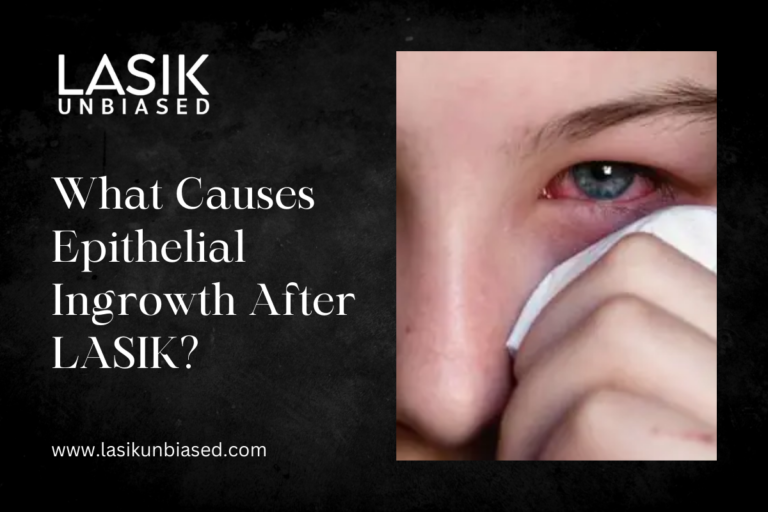Epithelial ingrowth is a rare but known complication that can occur after LASIK surgery. It happens when epithelial cells generally cover the cornea’s surface and grow underneath the corneal flap created during LASIK.
This condition is usually mild and does not cause significant vision problems. However, excessive cell growth can lead to discomfort, blurred vision, or even flap complications in some instances. Understanding the causes of epithelial ingrowth helps prevent and manage this condition effectively.
How Epithelial Cells Move Under the Flap
During LASIK surgery, a surgeon creates a thin flap on the cornea using a microkeratome or a femtosecond laser. This flap is lifted to allow the laser to reshape the underlying corneal tissue for vision correction. After the procedure, the flap is repositioned without stitches, allowing it to heal naturally. However, in some cases, epithelial cells from the corneal surface migrate beneath the flap before fully adhering, leading to epithelial ingrowth.
Primary Causes of Epithelial Ingrowth
Flap Manipulation During Surgery
One of the most common causes of epithelial ingrowth is excessive manipulation of the corneal flap during surgery. If the flap is handled too much or does not align perfectly when repositioned, it may create space for epithelial cells to migrate underneath. Modern LASIK techniques minimize this risk by using precise laser technology to create smooth, uniform flaps.
Pre-Existing Epithelial Defects
Patients with irregularities in their epithelial layer before LASIK surgery may be more prone to epithelial ingrowth. Conditions such as dry eye syndrome or corneal abrasions can make it easier for epithelial cells to loosen and migrate under the flap. To reduce this risk, surgeons carefully assess corneal health before performing LASIK.
Age and Healing Factors
Older patients have a slightly higher risk of developing epithelial ingrowth because the adhesion of the LASIK flap may not be as strong as in younger individuals. Healing rates vary from person to person, and those with slower healing responses may be more susceptible to epithelial cells infiltrating the flap interface.
Flap Re-Lifting for Enhancements
Epithelial ingrowth is commonly seen in patients undergoing a LASIK enhancement procedure. When the flap is lifted again for a second correction, it disrupts the natural healing and adhesion process, increasing the likelihood of epithelial cell migration. The risk is notably higher if the enhancement is done years after the initial surgery, as the flap may not fully reseal with age.
Post-Surgery Trauma or Rubbing the Eyes
Excessive eye rubbing or accidental trauma soon after LASIK can displace the flap and allow epithelial cells to migrate underneath. To prevent complications, patients are advised to avoid touching or putting pressure on their eyes during the initial healing period.
Surgical Technique and Flap Creation Method
The technique used to create the LASIK flap plays a role in epithelial ingrowth risk. Flaps created with a mechanical microkeratome are slightly more risky than those made with a femtosecond laser. The laser technique produces smoother, more precise edges, allowing better flap adhesion and reducing the chances of epithelial migration.
Signs and Symptoms of Epithelial Ingrowth
Most cases of epithelial ingrowth are mild and do not cause noticeable symptoms. However, when the condition becomes significant, it can lead to:
- Blurred or hazy vision
- Light sensitivity
- Discomfort or irritation in the affected eye
- Foreign body sensation
- Small white or grayish spots near the flap edges
- Flap irregularities or wrinkling in severe cases
Early detection through routine follow-ups ensures timely intervention before symptoms worsen.
How Epithelial Ingrowth Is Treated
Monitoring for Mild Cases
If epithelial ingrowth is minimal and does not affect vision, doctors may monitor it without taking immediate action. Many cases resolve naturally without intervention.
Flap Lift and Cell Removal
In more advanced cases, surgeons may need to lift the flap and manually remove the ingrown cells. This procedure uses specialized tools to clean the interface between the flap and the cornea. The flap is then repositioned securely to prevent further cell migration.
Use of Mitomycin-C
In cases of recurrent epithelial ingrowth, surgeons may apply a medication called mitomycin-C during the removal procedure. This medication helps prevent regrowth by inhibiting the proliferation of epithelial cells.
Flap Suturing or Adhesive Agents
In rare cases where epithelial ingrowth continues to recur, doctors may use microscopic sutures or tissue adhesive to ensure the flap stays tightly sealed. This approach is uncommon but effective in preventing further cell migration.
Preventing Epithelial Ingrowth After LASIK
While not all cases of epithelial ingrowth can be predicted, certain precautions help reduce the risk:
- Choosing an experienced LASIK surgeon who uses advanced laser techniques
- Avoiding rubbing the eyes after surgery to prevent flap displacement
- Following post-operative care instructions carefully
- Using prescribed lubricating eye drops to promote smooth healing
- Attending all follow-up appointments to detect early signs of ingrowth
Epithelial ingrowth is a rare but manageable complication after LASIK. Understanding its causes, such as flap manipulation, pre-existing epithelial defects, and post-surgery trauma, allows patients and doctors to take preventive measures. With advancements in LASIK technology and proper post-operative care, the risk of epithelial ingrowth remains low. Regular eye check-ups ensure early detection and effective treatment, allowing patients to maintain clear and comfortable vision after LASIK.


